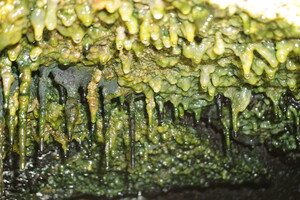Deposits were formed 65-800 years ago.

Scientists from several American institutes discovered many previously unknown microbes that live in geothermal caves, lava tubes, and volcanic vents in Hawaii. According to Science Alert, these deposits were formed 65-800 years ago and practically do not receive sunlight.
In addition, poisonous gases may be present here. However, the presence of microbial mats is a common feature of all Hawaiian lava caves.
Read also: Conditions under the surface of Mars are suitable for the existence of microbes – scientists
The researchers sampled mats between 2006 and 2009, and then again between 2017 and 2019. Their analysis revealed many more unique life forms than expected. When the researchers sequenced 70 samples for a single RNA gene commonly used to determine microbial diversity and abundance, they were unable to match any results to known genera or species with a high degree of confidence. According to the researchers, this shows that these caves are a little-studied and diverse ecosystem.
Subterranean microbes have attracted increasing attention in recent years because they live in Martian-like conditions. But, according to the latest estimates, we still do not know 99.9% of microbes, which is why they are sometimes called dark matter.
A new study from Hawaii shows how much we still have to learn. At the same time, the diversity of bacteria in different layers was not the same. Those between 500 and 800 years old had more bacteria than geothermal sites or those less than 400 years old.
While the older sites were more diverse, the younger ones had more complex interactions. This was probably due to less diversity. Microorganisms had to work together to survive.
Scientists also suggest that microbes need time to colonize volcanic basalts. As the environment changes, so does the structure of their community. In younger lava deposits, the microbes were more distantly related. This suggests that competition was stronger in harsher environments, reducing the likelihood of closely related species cohabiting.
Several classes of bacteria, such as Chloroflexi and Acidobacteria, were present at nearly all sites regardless of age. Scientists have called them “hub” bacteria because they combine other microbes. It is possible that Chloroflexi may act as carbon sources in the ecosystem, using light energy in relation to dark conditions.
However, this is only speculation. Scientists have sequenced only one gene, so they cannot yet say what the role of a particular microbe is in the community.
Earlier, scientists from the Chinese Academy of Sciences stated that melting glaciers in the Tibetan highlands could lead to release of new types of bacteria. They managed to find 1,000 types of microorganisms here, hundreds of which are still unknown to science.




